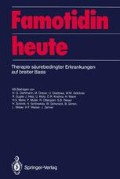Zusammenfassung
Die Rezidivhäufigkeit des Ulcus duodeni innerhalb eines Jahres liegt in kontrollierten Studien zwischen 50 bis 90%, je nach untersuchtem Kollektiv [4, 24]. Raucher haben mehr Rezidive als Nichtraucher [10]. Lange Dauer der Anamnese, schlechte Heilungstendenz des akuten Ulcus, Ulcusgröße, vermehrte Säuresekretion und jugendliches Alter führen zu häufigerem Auftreten von Ulcus-duodeni-Rezidiven [4, 10 bis 12, 15 bis 17, 20]. Die Letalitätsrate bei der Ulcuskrankheit liegt bei 1,4% innerhalb von 9 Jahren [5]. Todesursachen sind Blutungen, Perforationen und Penetrationen. Die Komplikationsrate ist bei über 50jährigen höher als bei unter 50jährigen [17]. Somit stellen die nicht ganz vollständige Abheilung eines Ulcus duodeni, eine akute gastrointestinale Blutung als Folge eines Ulcus und das Rauchen Risikofaktoren dar, die eine medikamentöse Prophylaxe indiziert erscheinen lassen.
Access this chapter
Tax calculation will be finalised at checkout
Purchases are for personal use only
Preview
Unable to display preview. Download preview PDF.
Literatur
Alstead E M, Ryan F P, Holdsworth M G, Asthton M G, Moore M (1983) Ranitidine in the prevention of gastric and duodenal ulcer relapse. Gut 24: 418–420
Baglioni A, Barbara L, Bianchi-Porro G et al (1985): Famotidin versus Plazebo in der Rezidivprophylaxe der Ulcus duodeni-Erkrankung. 23: 665–669
Baker L R, Ackrill P, Cattell W R, Stamp TC, Watson L (1974): Iatrogenic osteomalacia and myopathy due to phosphate depletion. Br Med J 3: 150–152
Blum A L (1987): Indikationen und Verfahrenswahl bei der Rezidivprophylaxe. In: Blum A L, Siewert T R et al (Hrsg) Ulcusalmanach 1, Springer, Berlin Heidelberg New York Tokyo, pp 1–14
Bennevie O (1977): Causes of deaht in duodenal and gastric ulcer. Gastroenterology 73: 1000–1004
Boyd E J S, Wormsley K G (1987): Konservative Maßnahmen bei der Prophylaxe. In: (Blum A L, Siewert et al.) Blum A L, Siewert T R et al. (Hrsg) Ulcusalmanach 1, Springer, Berlin Heidelberg New York Tokyo, pp 15–28
Cheli R, Giocosa A, Molinari G (1982): Long term treatment of duodenal ulcer with pirenzepine. Scand J, Gastroent erol 17 [Suppl]: 221–224
Federici I, Accadia L, Gabbrielli L, Giorgi-Conciato M, (1983): Gabbrielli A L, Long term treatment of duodenal ulcer with pirenzepine; gastric pH valuis and incidende of relapse: an open pilot study. Int J Tissue React V (4): 353–355
Hagenmüller F (1983): Klinische Erfahrungen mit Sucralfat: Rezidivprophylaxe. Swiss Med 5: 28–32
Korman M G, Shaw R G, Hansky J, Schmidt G T (1981): Influence of smoking on healing rate of duodenal ulcer in response to Cimetidine or high-dose antacid. Gastroenterology 80: 1451–1453
Krag E (1966): Long-term prognosis in medically treated peptic ulcer. A clinical, radiographical and statistical follow-up study. Acta Med Scand 180: 657–670
Krause U (1963): Long-term results of medical and surgical treatment of peptic ulcer. A follow-up investigation of patients initialy treated conservatively between 1925 - 1934. Acta Chir Scand [Suppl] 310: 1–111
Moshal M G, Spitaels J M, Khan G L et al (1982): Pirenzepine,Cimetidine and placebo in the long term treatment of duodenal ulceration. A comparative study. S. Afr. Med. J. 62: 12–14
Pace F et al. (1985) Therapie des Ulcus ventriculi mit niedrig dosiertem Antacidumgel und Cimetidin. Dtsch Med Wochenschr 110: 283–287
Piper D W, Greig M, Coupland GAE, Hobbin E, Shinners J (1975): Factors relevant to the prognosis of chronic gastric ulcer. Gut 16: 714–718
Piper D W], Shinners J, Greig M, Thomas J, Waller S L (1978): Effect of ulcer healing on the prognosis of chronic gastric ulcer. Four year follow- up. Gut 19: 419–428
Pulvertaft C N (1968): Comments on the incidence an natural history of gastric and duodenal ulcer. Postgrad Med J 44: 597–602
Rickenbacher U, Schlatter C (1983): Toxikologie und Verbreitung von Aluminium-Verbindungen. Naturwissenschaften 70: 303–304
Rutgeerts P, Vantrappen G, Brassine A, Van Maercke Y, Pen S (1985): Prevention of uodenal ulcer by pirenzepine 50 mg. Gastroenterology 88 (5): A 1563
Sonnenberg A, Kiene K, Weber K B, Pelloni S, Peter P, Wienbeck M, Strohmeyer G, Blum A L (1979): Rezidivprophylaxe des Ulcus duodeni mit Cimetidin. Dtsch Med Wochenschr 104: 725–730
Steinberg W M, Lewis J H, Katz D M (1982): Antacids inhibit the absorption of Cimetidine. N Engl J Med 307: 400–404
Stadelmann O, Groh E (1986): Rezidivprophylaxe der Ulcus-duodeni- Erkrankung mit Famotidin (Ergebnisse einer europäischen Studie). In: Simon B, Bianchi-Porro G, Dammann H G (Hrsg), Internationais Symposium im Rahmen des 17. Kongresses der Europäischen Gesellschaft für Gastroenterologie u. Endoskopie, Berlin, März 1985. Thieme, Stuttgart, S 71
Texter E C, Navab F, Mantell G, Berman R (1986): Maintenance Therapy of Duodenal Ulcer with Famotindine. Am J Med 81: 25–32
Wormsley, K G (1984): Assesing the safety of drugs for the long-term treatment of peptic ulcer. Gut 25: 1416–1423
Rights and permissions
Copyright information
© 1989 Springer-Verlag Berlin Heidelberg
About this paper
Cite this paper
Zehner, J., Weber, L., Hotz, J. (1989). Langzeitbehandlung des Ulcus duodeni mit Famotidin. In: Famotidin heute. Springer, Berlin, Heidelberg. https://doi.org/10.1007/978-3-642-73807-4_6
Download citation
DOI: https://doi.org/10.1007/978-3-642-73807-4_6
Publisher Name: Springer, Berlin, Heidelberg
Print ISBN: 978-3-642-73808-1
Online ISBN: 978-3-642-73807-4
eBook Packages: Springer Book Archive

